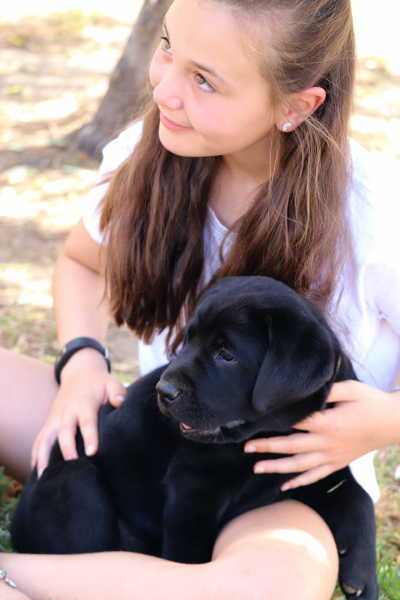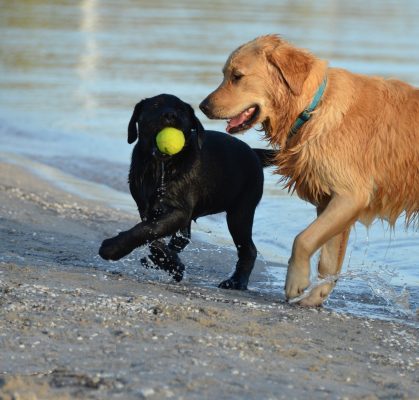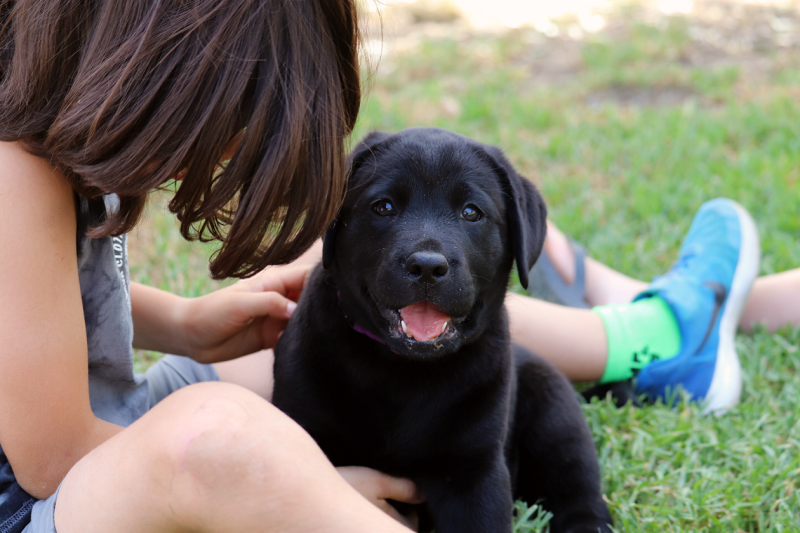Socialising your puppy
Once your puppy has completed his vaccinations and is fully immunised (after his second vaccination at 10 – 12 weeks old), he can start going out and about with you.
Socialisation is the process by which puppies learn to relate appropriately to people, other animals and situations around them. It involves meeting and having pleasant encounters with as many adults, children, dogs, and other animals, as well as becoming used to a wide range of events, environments, and situations.
Experiences during the first year of a dog’s life can make all the difference to their future temperament and character. Taking time to socialise your puppy results in a friendly, well-adjusted adult dog who enjoys the company of people and can be taken anywhere and lives life to the full!
A puppy who lacks experiences with the world will find many things we take for granted scary and is likely to grow up a worried dog. A frightened, anxious and insecure puppy is more likely to develop behaviour problems, than a dog who has a rich, varied and positive puppyhood.
The sooner the better.
This is because as puppies get older, they become more cautious when faced with new experiences. The early weeks are particularly important because puppies will approach anything and anybody willingly and without fear.
Puppies go to new homes at eight weeks old. After their second vaccination is the perfect time to introduce your new puppy to the world as they will be particularly receptive to new experiences. It’s important to build on and continue this as your puppy gets older as, if socialisation stops, they may become worried or fearful. Continue to make real effort, especially in the first year and you should be rewarded with a friendly and steady dog that can be taken anywhere!
How to socialise
All you have to do is take your puppy out and about as much as possible as soon as they have settled in, taking care not to overwhelm them. You’ll have to balance this with protecting them from situations and places where there are hazards or risks of disease or infection.
Make sure you assess each situation first.
Does the person meeting your puppy have any experience with dogs?
 Adults and children – meeting a variety of people: men, women, children, different accents, different tones, different body language, children’s behaviour tends to be quite different to adults, postman, builder, handyman, friends.
Adults and children – meeting a variety of people: men, women, children, different accents, different tones, different body language, children’s behaviour tends to be quite different to adults, postman, builder, handyman, friends.
When meeting new people, YOU need to advocate for your puppy. Puppies are cute and people want to rush up and cuddle your puppy. This should not be allowed. If someone wants to pat your puppy when you’re out walking and meeting new people, ask them to wait several steps away from you. Allow the puppy to approach the person, rather than the other way around – this way, you can be sure your puppy is feeling confident enough to meet somebody unfamiliar. Once the puppy has sniffed the person, they may stroke the puppy – but not on his head. Have them stroke the puppy on the side of his shoulders or back.
You can create these encounters, as above, for your puppy. Go for a walk in town. Tell people you are socialising your puppy and ask them would they like to pat him. Then talk them through the process of how the puppy is going to meet them. Most people are very willing to do this!
Engineer scenarios that are positive and rewarding for your puppy.
During all encounters, protect your puppy from bad experiences. Young puppies are inexperienced and get themselves into trouble easily, so think ahead and try to prevent any unpleasant events from occurring. This said, don’t go around being anxious yourself, as your puppy can sense your anxiety and this definitely translates to the puppy through your body language, hormones, leash pressure and tone. So relax, but be alert.
Don’t allow people to crowd the puppy – not too many people all at once.
Observe your puppy constantly for signs of anxiety or being overwhelmed and if things are getting too much, remove them from the situation or give your dog more space and freedom to approach.
Tips
Never pick up your puppy and pass them to someone or pull your puppy towards them. Puppies should be able to make an approach in their own time and retreat if they want to.
An anxious puppy will try to look smaller, avoid eye contact, hold their tail low, put their ears back and pull away. They may also lick their lips or yawn. Make sure you pay attention to these signs and take action as soon as possible, usually by taking your puppy away form whatever is causing them to be worried.
A happy puppy is relaxed, will stand up straight with their tail or whole body wagging and be keen to investigate.
Avoid using food when introducing your puppy to strangers as this may teach them that all people carry food on them and this is not idea. You’ll want your puppy to approach people because they want to say hello politely, not to receive treats!
Don’t allow your puppy to jump up or put his paws on people, not even on yourself.
 Other dogs and puppies
Other dogs and puppies
A puppy learns to interact appropriately with well-socialised adult dogs by spending time with them. Adult dogs can teach the puppies manners, respect and boundaries too.
Your puppy should be introduced to a variety of adult and young dogs and other puppies of different breeds and sizes. Ensure these dogs are safe around puppies. A bad experience can traumatize a puppy for a very long time, sometimes for life.
Spending play time with other dogs, puppies learn important skills such as not putting paws and teeth all over them unless invited to do so, and how to communicate effectively. Most adult dogs will tell the puppy off is they are too exuberant, others are very tolerant and may allow your puppy to play too roughly.
Always supervise play.
Think about how you want your puppy to behave with unfamiliar dogs that it meets when out and about. Dogs that play very physical games when young often learn to expect these sorts of games from all dogs which is likely to get them into trouble. If games get too boisterous, intervene by encouraging your puppy away and get them to focus on you instead.
Equally protect your puppy from the exuberant play of bigger dogs, especially if your puppy is shy. Crouch down to provide a safe haven and do not allow older dogs to frighten or bully your puppy.
Make sure other dogs they play with are fully vaccinated and are healthy.
Other animals and livestock
Puppies should observe and meet and a variety of other animals, but should be kept under control to prevent them learning to enjoy chasing. Reward your puppy verbally and with treats if they are calm and relaxed in these situations. If they become too excitable (which is only natural at first), create a bit of distance until they get used to staying calm in these situations.
Environments
Puppies need to encounter a variety of different environments and situations. This provides them the opportunity to become familiar with a wide range of different scents, sounds, and sights. If your dog is socialising well with humans, familiarisation with different environments should happen naturally. However, it is worth making an effort to check that your puppy is gradually becoming accustomed to car travel, traffic, the countryside, and towns.
Remember to think puppy – imagining how it feels to be that small, vulnerable and inexperienced, try to make sure your puppy is enjoying the experience and not feeling overwhelmed.
Checklist of things to socialise your puppy to
- Children and adults of all ages, men and women, different ethnicities and accents
- People with hats, glasses, sunglasses, facial hair, loose flapping clothing
- People on crutches, wheelchairs, bicycles, children in prams
- People on motorbikes, scooters, skates
- Other dogs, cats, small pocket pets, horses, sheep, farm animals
- Wild animals, kangaroos
- Parks, car parks, gardens
- Sidewalks, paths of different textures
- Pet stores, vet clinics, other people’s homes and yards, boarding kennels
- Ponds, rivers, beach, bushland, paddocks, pools, forest tracks, mountains
- Different surfaces – grass, slippery floors, tiles, stairs, wobbly surfaces, mud, sand, carpet, pavers, concrete, stones, rocks
- Travelling in the car, train, bus, boat
- Grooming and bath time, groomer salon
- Nail clipping and paws being touched
- Ears, face and teeth being touched and examined
- Leash and obedience training, crate training
- Noises – vacuums, fireworks, traffic, hair dryer, microwave, music, crowds, rain, thunder
- Wearing socks on feet, bandages on legs
- Wearing a protective coat, wearing a dog-life vest for swimming and boating
- Sitting on weigh scales at vet clinic
- Nursing homes, schools, shopping centres
Shy puppies
Different puppies have different sensitivities. While we make every effort to expose the puppies to a different experiences between birth and 8 weeks old, there are many more things they have never encountered.
A shy puppy will need more support, more time. Shy puppies are going to be more comfortable to ‘watch the world’ from a distance at first, and as they relax you’ll be able to gradually increase their level of exposure.
Do not force the puppy. Let the puppy explore, approach and face experiences at his or her pace.
If the puppy is shy of strangers, people can change their body language to encourage the puppy. Crouching down to make oneself smaller, talking gently, allowing the puppy longer time and longer sniffing time before patting, avoiding eye contact and turning ones head away slightly can help the puppy be more comfortable as these behaviours mean ‘no threat’ to the puppy.
Vet clinics and medical procedures
Many dogs are shy of vets and clinics. Unfortunately, dogs usually only go the vet if something is wrong. So dogs learn to associate vet clinics with pain, unpleasant experiences and fearfulness.
Start taking the puppy there (after his second vaccination) just for visits in the waiting room. Have the vet nurses and receptionists pat him and talk to him. Allow him time to look around and practice weighing him on the vet scales. Ask the vet nurses to bring nail clippers, electric fur clippers, syringes, stethoscope, and medical instruments near him and allow him to sniff them, before having them touch these equipment on various parts of his body, while you encourage and reward him with treats. Ask the vet nurses to inspect his paws and ears, to condition him for formal veterinary examinations.
And just sit with him for a while in the waiting room, then get up and leave.
This teaches him that not every time he comes to the clinic something unpleasant will happen.
Puppy Classes
A good puppy class can help with socialisation and get you started with your training, but remember a weekly session won’t be enough and the majority of the work should be done by you away from class.
We recommend waiting until the second vaccination to start puppy classes, although there are classes for puppies 8 – 12 weeks old at some obedience schools (professional trainers) and vet practices (usually not run by professional dog trainers).
Classes should be well controlled and planned, small in size (classes of more than ten are going to be chaotic). Reward based training is encouraged. Classes should involve people as well as puppies. Environment should be clean, not cluttered, and space for puppies to move away if overwhelmed. Classes should be run by a qualified dog trainer.

